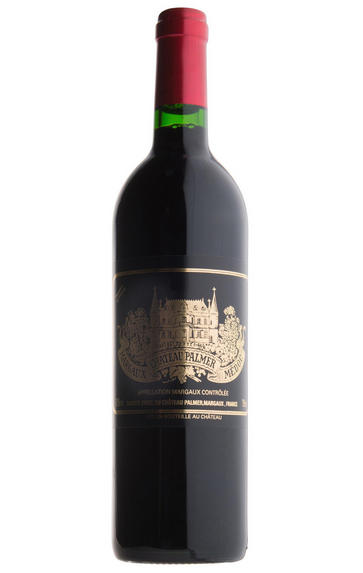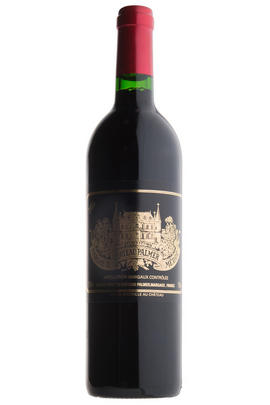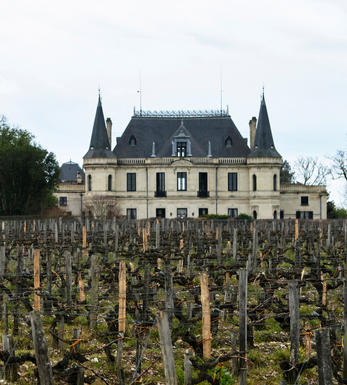
2005 Château Palmer, Margaux, Bordeaux

Critics reviews
The 2005 Palmer has been absolutely magical both times I have tasted it recently. Still wonderfully deep to the core, the 2005 is dense, packed to the core and luxuriously opulent. Even with all of that intensity, the 2005 remains vibrant. Lush red/purplish berry fruit, rose petal, lavender and sweet spice build into the towering finish. The 2005 is an epic wine that will have no problem reaching its fiftieth birthday. It is a rich, dramatic Margaux that checks all the boxes, and then some. I rated a second bottle even higher.
Drink 2023 - 2055
Antonio Galloni, Vinous.com (April 2021)
Enticing ruby red body, with aromatics that show a touch of orange zest and turmeric spice. The fruit is creamy, intense, a brilliant Palmer that has finesse and balance but a serious kick. Black pepper, cinammon, raspberry, bilberry fruits, smoked earth and campfire on the finish, so juicy, totally salivating with a slate-textured close of play. Delicious, and a great sign that the 2005 vintage is starting to swing open. Harvest September 22 to October 7, 60% new oak. A long dry summer, with 57% less rainfall than usual, although temperatures never climbed as high as in 2003. Impossible to stop smiling after this.
Drink 2021 - 2045
Jane Anson, JaneAnson.com (July 2021)
53% Cabernet Sauvignon, 40% Merlot, 7% Petit Verdot.
Impressive nose, driven by powerful but balanced acetic aromas as well as black cherry, toasted oak, farmyard, dark chocolate and olives. Wonderful breadth and depth, perhaps not as floral as you might expect from Margaux, classically. There is plenty of tannin though, and the wine is still only just opening up. A wine for the ages.
Drink 2015 - 2035
Richard Hemming MW, JancisRobinson.com (August 2022)
Tasted at the Château Palmer vertical in London, the 2005 Château Palmer is a legend in the making. Apparently the vines received 57% less rain than average, yet the 2005 shrugs off any water deficiency and has nurtured a wondrously pixelated bouquet, whereby mineralité shines through the black cherry and blueberry fruit. Search deeper and you discover veins of graphite that impart a Pauillac-like allure.
The palate is medium-bodied and intense, but it is not overwhelming, a Margaux that is galvanized with a firm backbone thereby ensuring this will age over the long term. The symmetry here is enthralling - a 2005 that is destined for greatness. The only question is whether it will surpass the 2009 or 2010 Palmer? It will be fun finding out. Tasted May 2015.
Drink 2022 - 2050
Neil Martin, Wine Advocate (May 2016)
Its bigger sister, the 2005 Château Palmer (53% Cabernet Sauvignon, 40% Merlot and 7% Petit Verdot), is one of the great efforts of this superlative vintage. Floral notes mixed with blackberry, cassis, plum, licorice and spring flowers soar from the glass of this dense ruby/purple wine. It is medium to full-bodied, surprisingly opulent (it has a big percentage of Merlot), long, multi-dimensional and textured. This wonderfully pure, stunning wine once again performs as a first-growth. It should drink well for the next 20-25 years.
Drink 2015 - 2040
Robert M. Parker, Jr., Wine Advocate (June 2015)
Superb bouquet of black fruits with dry spice, tobacco and liquorice. Densely textured palate with incredible backbone: ‘2015 has all the charm we had in 2009 but more precision to make a serious wine without being severe,’ says CEO Thomas Duroux.
Drink 2022 - 2045
Steven Spurrier, Decanter.com
About this WINE

Château Palmer
Château Palmer is a leading wine estate in Margaux. Within its appellation, Palmer is certainly the closest rival to its first growth neighbor, Ch. Margaux. Although officially ranked a Third Growth, at their best, the wines of Ch. Palmer are among the greatest anywhere in Bordeaux.
The estate dates to the 17th century, though it was not until 1814 that Englishman Charles Palmer took ownership and gave it his name. In 1938, the estate was bought by four Bordeaux négociant families, two of whom – Sichel and Mähler-Besse – still own the property today. Since 2004, the estate has been led by the charismatic agronomist and oenologist Thomas Duroux, who had previously made wine at Ornellaia in Tuscany.
Thomas undertook major renovations, including completely modernizing the grape reception area, the vat rooms, and barrel cellar. In the vineyards, the technical team began experimenting with biodynamic farming, and today Palmer is among the leading biodynamic vineyards in Bordeaux. In addition to the grand vin, the Ch. Palmer’s portfolio also includes a cuvée called Alter Ego.
Introduced in 1998, Alter Ego is produced from grapes grown on dedicated plots and blended differently from the grand vin. As such, the estate regards it not as a second wine but as a distinctive cuvée in its own right.
Palmer lies in the commune of Cantenac, just outside the village of Margaux. 66 hectares of vines are planted on a plateau of gravel, sand, and clay soils overlooking the Gironde estuary. Plantings include equal parts of Merlot and Cabernet Sauvignon at 47% each and 6% Petit Verdot. Although the average age of the vines is fairly typical of the region at about 40 years, some of the vines are over 70 years old. That, along with the relatively high Merlot content and the benefits of careful, well-established biodynamic practices, may account for the wines’ richness and complexity.
Fermentation occurs in conical, stainless-steel vats in varying sizes, allowing each variety and parcel to be fermented separately for subsequent selection and blending. The grand vin is aged for 20-22 months in barrels, of which less than 50% is new. Thanks to the health and consistency of the estate’s biodynamically produced fruit, Palmer has been able, over the past few years, to safely reduce the quantity of sulfites added throughout the process, aiming to produce wines with more freshness and purity of flavor. For Alter Ego, less new wood is used, and aging time is slightly reduced to produce a wine the estate describes as “distinguished by its freshness of fruit, crisp intensity, and richness from the moment out of the barrel”.
Between 2008 and 2013, Ch. Palmer made the transition to 100% biodynamic farming. In addition to its vineyards, the estate is home to a diversity of complementary plants and grazing animals.

Margaux
If Pauillac can be seen as the bastion of ‘traditional’ Red Bordeaux, then Margaux represents its other facet in producing wines that are among Bordeaux’s most sensual and alluring. It is the largest commune in the Médoc, encompassing the communes of Cantenac, Soussans, Arsac and Labaude, in addition to Margaux itself. Located in the centre of the Haut-Médoc, Margaux is the closest of the important communes to the city of Bordeaux.
The soils in Margaux are the lightest and most gravelly of the Médoc, with some also containing a high percentage of sand. Vineyards located in Cantenac and Margaux make up the core of the appelation with the best vineyard sites being located on well-drained slopes, whose lighter soils give Margaux its deft touch and silky perfumes. Further away from the water, there is a greater clay content and the wines are less dramatically perfumed.
Margaux is the most diffuse of all the Médoc appelations with a reputation for scaling the heights with irreproachable wines such as Ch. Margaux and Ch. Palmer, but also plumbing the depths, with too many other châteaux not fulfilling their potential. There has been an upward shift in recent years, but the appellation cannot yet boast the reliability of St Julien. However, the finest Margaux are exquisitely perfumed and models of refinement and subtlety which have few parallels in Bordeaux.
Recommended Châteaux: Ch. Margaux, Ch. Palmer, Ch. Brane-Cantenac, Ch. Rauzan-Ségla , Ch. Dufort-Vivens, Ch. Ferrière, Ch. du Tertre, Ch. Giscours, Ch. d'Angludet.

Cabernet Sauvignon Blend
Cabernet Sauvignon lends itself particularly well in blends with Merlot. This is actually the archetypal Bordeaux blend, though in different proportions in the sub-regions and sometimes topped up with Cabernet Franc, Malbec, and Petit Verdot.
In the Médoc and Graves the percentage of Cabernet Sauvignon in the blend can range from 95% (Mouton-Rothschild) to as low as 40%. It is particularly suited to the dry, warm, free- draining, gravel-rich soils and is responsible for the redolent cassis characteristics as well as the depth of colour, tannic structure and pronounced acidity of Médoc wines. However 100% Cabernet Sauvignon wines can be slightly hollow-tasting in the middle palate and Merlot with its generous, fleshy fruit flavours acts as a perfect foil by filling in this cavity.
In St-Emilion and Pomerol, the blends are Merlot dominated as Cabernet Sauvignon can struggle to ripen there - when it is included, it adds structure and body to the wine. Sassicaia is the most famous Bordeaux blend in Italy and has spawned many imitations, whereby the blend is now firmly established in the New World and particularly in California and Australia.


Buying options
Add to wishlist
Description
Awesome. Showstopping. Remarkable. Palmer is all of these things in 2005. A stunning, full bodied expansive beauty of a wine, it is quintessentially Margaux with a Pomerol-like richness. It is silky and gorgeous with unbelievably pure, firm and precise fruit on the palate. With multiple layers of complexity, the finish was so long we could still taste it - without any exaggeration - 15 minutes after leaving the château. The 78-year-old former winemaker said the only vintage to compare to the 2005 was the 1945 and in his view the 2005 surpassed the legends of 1961, 1983 and 1989 at the same stage.
Berry Bros. & Rudd
wine at a glance
Delivery and quality guarantee